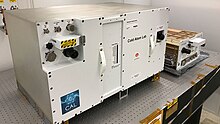Cold Atom Laboratory: Difference between revisions
Allforrous (talk | contribs) →External links: Commonscatinline template. |
Upgraded narration above elementary school level. |
||
| Line 2: | Line 2: | ||
The '''Cold Atom Laboratory''' ('''CAL''') is an experimental instrument being developed that was originally scheduled for launch to the [[International Space Station]] (ISS) in June 2017. <ref name=":0">{{Cite web|url=https://coldatomlab.jpl.nasa.gov/|title=Cold Atom Laboratory|website=coldatomlab.jpl.nasa.gov|access-date=2019-08-29}}</ref> It was then delayed until a scheduled launch on a [[SpaceX]] CRS-12 rocket in August 2017.<ref name="Physics World - the member magazine of the Institute of Physics">{{cite web |url=http://physicsworld.com/cws/article/news/2017/mar/08/nasa-to-launch-cold-atom-lab-in-space |title=NASA to launch Cold Atom Lab in space }}</ref> It was launched in May 21, 2018.<ref>{{Cite news|url=https://qz.com/1286544/nasa-is-creating-a-super-cold-lab-in-space-to-study-quantum-physics//|title=NASA is creating a super cold lab in space to study quantum physics/|date=2018-05-24|work=QUARTZ|access-date=2018-05-24|language=en-US}}</ref> |
The '''Cold Atom Laboratory''' ('''CAL''') is an experimental instrument being developed that was originally scheduled for launch to the [[International Space Station]] (ISS) in June 2017. <ref name=":0">{{Cite web|url=https://coldatomlab.jpl.nasa.gov/|title=Cold Atom Laboratory|website=coldatomlab.jpl.nasa.gov|access-date=2019-08-29}}</ref> It was then delayed until a scheduled launch on a [[SpaceX]] CRS-12 rocket in August 2017.<ref name="Physics World - the member magazine of the Institute of Physics">{{cite web |url=http://physicsworld.com/cws/article/news/2017/mar/08/nasa-to-launch-cold-atom-lab-in-space |title=NASA to launch Cold Atom Lab in space }}</ref> It was launched in May 21, 2018.<ref>{{Cite news|url=https://qz.com/1286544/nasa-is-creating-a-super-cold-lab-in-space-to-study-quantum-physics//|title=NASA is creating a super cold lab in space to study quantum physics/|date=2018-05-24|work=QUARTZ|access-date=2018-05-24|language=en-US}}</ref> |
||
The instrument will create extremely cold conditions in the [[microgravity]] environment of the ISS leading to the formation of [[Bose–Einstein condensate|Bose Einstein Condensate]]s that are a magnitude colder than those that are created in laboratories on Earth.<ref name=":0" />In a space-based laboratory, up to 10 seconds interaction times and as low as 1 picokelvin temperatures are achievable, and it could lead to exploration of unknown [[Quantum mechanics|quantum mechanical]] phenomena and test some of the most fundamental laws of physics.<ref name="CALnasa">{{cite web |url=http://www.nasa.gov/mission_pages/station/research/news/cold_atom_lab/ |title=Cold Atom Laboratory Creates Atomic Dance |website=NASA News |date=26 September 2014 |accessdate=2015-05-21 }}</ref> <ref name=":0" /> These experiments |
The instrument will create extremely cold conditions in the [[microgravity]] environment of the ISS leading to the formation of [[Bose–Einstein condensate|Bose Einstein Condensate]]s that are a magnitude colder than those that are created in laboratories on Earth.<ref name=":0" />In a space-based laboratory, up to 10 seconds interaction times and as low as 1 picokelvin temperatures are achievable, and it could lead to exploration of unknown [[Quantum mechanics|quantum mechanical]] phenomena and test some of the most fundamental laws of physics.<ref name="CALnasa">{{cite web |url=http://www.nasa.gov/mission_pages/station/research/news/cold_atom_lab/ |title=Cold Atom Laboratory Creates Atomic Dance |website=NASA News |date=26 September 2014 |accessdate=2015-05-21 }}</ref> <ref name=":0" /> These experiments are best done in a freely falling environment, because it's more conducive to uninhibited formation of Bose Einstein Condensates. Ground based experiments suffer from the effect of the Condensate interacting assymetrically with the apparatus, interfereing with the time evolution of the Condensate. On orbit, experiments can last much longer because freefall is sustanied indefinitely.<ref name=":0" /> [[NASA|NASA's]] [[JPL]] scientists state that the CAL investigation could advance knowledge in the development of extremely sensitive quantum detectors, which could be used for monitoring the gravity of Earth and other planetary bodies, or for building advanced navigation devices.<ref name=":0" /> |
||
The initial mission will have a duration of 12 months with up to five years of extended operation.<ref name=":0" /> |
The initial mission will have a duration of 12 months with up to five years of extended operation.<ref name=":0" /> |
||
Revision as of 19:23, 12 May 2020

The Cold Atom Laboratory (CAL) is an experimental instrument being developed that was originally scheduled for launch to the International Space Station (ISS) in June 2017. [1] It was then delayed until a scheduled launch on a SpaceX CRS-12 rocket in August 2017.[2] It was launched in May 21, 2018.[3]
The instrument will create extremely cold conditions in the microgravity environment of the ISS leading to the formation of Bose Einstein Condensates that are a magnitude colder than those that are created in laboratories on Earth.[1]In a space-based laboratory, up to 10 seconds interaction times and as low as 1 picokelvin temperatures are achievable, and it could lead to exploration of unknown quantum mechanical phenomena and test some of the most fundamental laws of physics.[4] [1] These experiments are best done in a freely falling environment, because it's more conducive to uninhibited formation of Bose Einstein Condensates. Ground based experiments suffer from the effect of the Condensate interacting assymetrically with the apparatus, interfereing with the time evolution of the Condensate. On orbit, experiments can last much longer because freefall is sustanied indefinitely.[1] NASA's JPL scientists state that the CAL investigation could advance knowledge in the development of extremely sensitive quantum detectors, which could be used for monitoring the gravity of Earth and other planetary bodies, or for building advanced navigation devices.[1]
The initial mission will have a duration of 12 months with up to five years of extended operation.[1]
See also
References
- ^ a b c d e f "Cold Atom Laboratory". coldatomlab.jpl.nasa.gov. Retrieved 2019-08-29.
- ^ "NASA to launch Cold Atom Lab in space".
- ^ "NASA is creating a super cold lab in space to study quantum physics/". QUARTZ. 2018-05-24. Retrieved 2018-05-24.
- ^ "Cold Atom Laboratory Creates Atomic Dance". NASA News. 26 September 2014. Retrieved 2015-05-21.
External links
 Media related to Cold Atom Laboratory at Wikimedia Commons
Media related to Cold Atom Laboratory at Wikimedia Commons- Cold Atom Laboratory – Project web site at JPL

